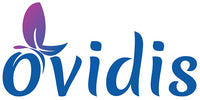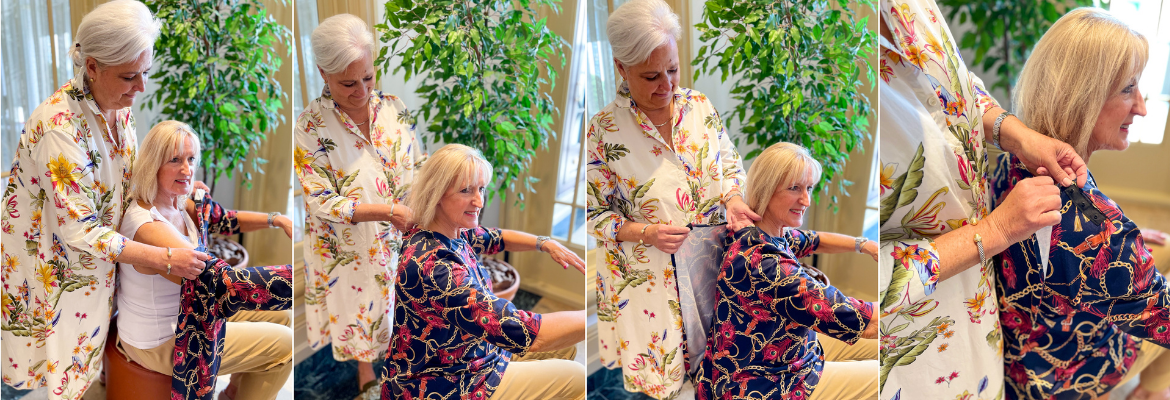Additional tool at the service of their occupational therapist
Reference: Occupation Ergothérapeute, "La revue de l'ordre des ergothérapeutes du québec" VOL.02, N.03, Été 2021

Understanding the importance of adaptive clothing in the elderly’s and people suffering from a loss of autonomy’s routine.
As discussions about inclusivity are at the forefront of discussions held in society, it is important to ensure that the clothing needs of people with reduced autonomy and reduced mobility are not only met, but also optimised. They need to have access to clothing that is not only functional but also up to date. We need to ensure we reduce the gap between clothing that meets medical needs and personal style until we no longer see a difference between the two.
The need for adaptive clothing emerged in the 1980s and the offer has continued to grow since because it allows people with reduced mobility or those suffering from cognitive disorders to have access to clothing that meets their needs while preserving their dignity.
As a health care professional, accessible clothing for disabled can become an asset as it helps facilitate dressing and helps lower the stress and anxiety related to this task. The ease with which aging seniors and people with reduced mobility can dress has a direct impact on their feeling safe and comfortable. It will in turn have a positive effect on their mood, their self-esteem, and self-confidence and consequently on their propensity to positively and actively participate in the activities that you have put in place for them.
In speaking with people who work in the health sector, we quickly realize the importance of the role played by occupational therapists with this clientele. Whether it is through sessions that stimulates their memory and cognitive functions, sessions on rehabilitation or exercises aimed at maintaining or making progress in relation to what they have acquired, all these sessions have a long-term effect on people’s daily lives and on their autonomy.
For example, it is possible to help them increase or develop their sense of self by involving them in choosing the clothes they will wear and they will be happy to do so when their clothing adequately meets their needs. We can also take the example of a person suffering from incontinence, adaptive clothing offers them greater comfort both in terms of the cut and in the ease with which the garments can be put on and taken off. This will ensure that the exercises proposed by the occupational therapist do not add to the fatigue created by the hassle and discomfort of their own clothes.
What is the value of accessible clothing for disabled?
Adaptive clothing’s first and foremost concern is to take into consideration the clothing needs of people with reduced autonomy and reduced mobility.
They offer larger openings, and as such are easier to put on and take off. This is all the more convenient when the person is in a sitting position, in a wheelchair or lying down. Adaptive wear also limits restrictive movements that have to be made or those that may be more difficult to do such as raising your arms in the air to put on a blouse or a shirt.
The fabrics used to design adaptive clothing are very carefully selected to meet several important criteria. They have to be durable, easy to care for and above all, very soft. This last aspect is especially important for people with increased sensory sensitivity.
Finally, they are discreet. Although we all want to have our own style, we don’t want this style to be unique because it comes from adaptive clothing. Adjustments made to the clothes are therefore carefully concealed so that the person wearing them does not feel different from the others.
How does the clothing industry perceive adaptive clothing?
It is starting to recognize the need for and importance of adaptive wear. Recent studies show that the number of elderly people with reduced mobility or who suffer from cognitive losses continues to increase. IT is therefore not only important that they can dress themselves, but that they can do so safely, with ease all while keeping their dignity.
OVIDIS, dressing made simple
Ovidis is sensitive to all those needs. The four women at the helm of the Laval based business all accompanied their respective mothers through their loos of autonomy and in their search for adaptive clothing that resembled them. It was also through discussions with health care professionals, including occupational therapists, that they realized the leading role proper adoptive wear could play on a daily basis on the mood, the self-confidence and the dignity felt by their loved ones.
However, they quickly realised that what was available on the market was lacking. Thus, was born Ovidis and its complete line of adaptive clothing for men and women that does not sacrifice style for the benefit of functional aspects required by individual medical needs. The Ovidis line of adaptive wear includes, among others, pants with side openings and pants with back panels whose waist is adjustable thanks to its Velcro closure, shirts with snaps, dresses, stylish and basic tops with back panels, jumpsuits, night gowns, pyjamas and more!
Visit us at www.ovidis.com to find out more about us. You can also contact us by email at info@ovidis.com, by phone at 1-833-736-7362, or by coming by our Head Office located at 4085, boul. Le Corbusier, Laval, Québec H4Y 0A5. We will be happy to meet with you and show you our collections.
‘Whatever your need for adapted clothing, Ovidis offers a wide selection of essential and up to date styles that will meet the needs of various clienteles while respecting their style and preserving their dignity."



